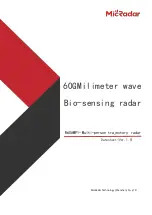
INTRODUCTION TO COMMANDS
2
If packets have been printing on the screen you may have forgotten which mode you are in. If you
wish to see the
cmd:
prompt do a
Ctrl-C
, to be sure you are in Command Mode. If the prompt
does not appear, then you are already in Command Mode, just type a RETURN [
↵
] if you wish to
see the
cmd:
prompt.
Format
All commands are listed alphabetically. On the first line of a command will be the command name
followed by any arguments required. Any optional arguments will be shown in square brackets [ ].
If the command accepts several different values, or a range of values, the permissible arguments
will be shown in parenthesis ( ). The permissible arguments may also be shown separated by a
vertical bar |. At the far right of the first line will be the version number which introduced this com-
mand. The second line will show the default value, which TNCs this command applies to, and what
modes of operation are affected by this command. Example:
COMmand
arguments
(permissible arguments)
version
default
units
modes
If the command applies differently to different units, the unit name will be in
italic
and listed sepa-
rately.
Parameter Types
n
(range)
Any number within the range is permissible. The unit of measures (seconds, ms, baud, count, etc.)
for the number will be described in the description. These are decimal numbers.
n
($00 – $FF)
Several parameters are numerical codes for characters which perform special functions. The code
is simply the ASCII character code for the desired character. (See the ASCII Chart at end of this
manual.) Most of these characters have control characters as default value. Control characters are
entered by holding down a special control key on the keyboard while typing an x, then release
both keys. These special characters cannot be sent in Packet unless preceded by the pass charac-
ter (see PASS) or unless you are operating in the Transparent Mode.
These numbers are shown in hexadecimal (hex) form (base 16). They can be entered either in
decimal or in hex. A hex number is distinguished from a decimal number by preceding it with a "$"
prefix. The "digits" of a hex number represent powers of 16, analogous to the power of 10 repre-
sented by a decimal number. The numbers 10 through 15 are denoted by the hex digits A through
F. For example:
$1B = (1 × 16) + 11 = 27
$120 = (1 × 16 × 16) + 2 × 16 + 0 = 288
Permissible values are shown as: (n = $00 – $FF). This is true if 8BITCONV is ON as defaulted. If
8BITCONV is changed to OFF, then permissible values are $00 – $7F. See the ASCII Chart at the
end of this book for character codes and hex/decimal conversion.
If a streamswitch (STREAMSW) character or any other special character is defined as "$" then you
will need to enter values in decimal, or precede the $ with the PASS character in order to enter
hex numbers.






































